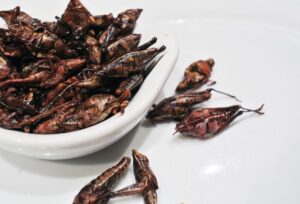
This week, I strolled around Stanley Park and noticed some strands of Purple Loosestrife in the woods near the Lost Lagoon. Honey bees milled around these slender, attractive light purple flowers. Nearby, a tourist took a photo of the pollination in-process.
The scene might have a calendar-art nature photo, except the flowers possessed a horrendous secret – these were alien invaders.
Purple Loosestrife – also known as the ‘beautiful killer’ – has gained a terrible image problem in recent times. This invasive Eurasian plant inhabits several marshlands on the Pacific coast, from British Columbia to California, and dominates wetlands, thus threatening several natural habitats. Once a favourite in the flower garden, Purple Loosestrife has transformed into a destructive, invasive pest.
British Columbia’s urban and semi-rural greenbelts are populated with several plants introduced from other parts of the world – most originate from the temperate zones of Europe and Asia. The majority of conservation specialists agree, the introduction of certain plants to North America – including
Purple Loosestrife,
Japanese Knotweed, and
Scotch Broom has been environmentally destructive.
Plant experts believe the tasty
Himalayan Blackberry is actually from Europe, and might have been introduced to the Himalayas. The confusion over the plant’s origins could have started in the 19
thcentury, when Luther Burbank introduced the
Himalayan Giant to the United States in 1885.
These sweet berries are food for the invasive Norway rat, and decrease the amount of pastoral land. The berries grow in crowded thickets measuring 600 canes per square metre, and the overpowering invasive absorbs much of the necessary sunlight required by the young native tree shoots to mature.
Common Gorse, another ornamental flower imported from Europe, contains highly flammable oils. This pleasant-appearing, yellow-flowered evergreen shrub also increases the level of nitrogen in the soil. Scotch Broom, a close relative of the Gorse, also introduces nitrogen into the soil, a chemical induction making the soil too fertile for native plants to become re-established.
The
Giant Hogweed, an Iranian/Russian immigrant from the Caucasus region, is an epic super-weed, which thrives in local areas such the Fraser Valley. In their art-band phase,
Genesis recorded a song in honour of this disgusting white-flowered monster, which grows up to 4.5 metres in large packs. The toxic sap from the Giant Hogweed is capable of burning and scarring human skin and can even induce blindness.
Sea travel is a common way for invasive creatures to travel to new host countries. The Asian tiger mosquito, which transmits dengue fever, yellow fever, and eastern equine encephalitis, arrived in United States from Japan in the 1980’s by surviving an ocean voyage in a shipment of used tires.
Foreign vegetation, animals, and insects are transported by accident in several various ways, but cargo ships appear to be the main culprit. These invaders often hide inside the ballasts of ships then the invasive seeds or larvae can be carried further inland by becoming attached to animal fur, or by floating along canals.
When some invasive plants or animals resettle in their new host countries, it’s a challenge to take on biologically sound restoration projects, which can be expensive, involve a generous amount of scientific study, and a significant amount of manpower.
Robert Doren, the assistant researcher for Florida’s Everglades National Park, used a costly method to exterminate the invasive
Brazilian Pepper from a large section of the park. The treated area required a drastic transformation to deprive the plant of its adapted fertilizer-rich soil habitat needed to sustain the Brazilian Pepper’s growth.
In 1997, Bulldozers were brought in, and the operators were ordered to strip almost 200 acres of the park down to bedrock. The lowered bedrock stratum is expected to contain a spread of native wetland grasses by 2016. The price tag for this intensive operation spanning several years cost a hefty $60 million.
Biocontrol is an attempt to use nature to manage invasive plants and pests. More than 100 varieties of insects have been studied to see if they have are capable of controlling the spread of Purple Loosestrife. This difficult procedure involved finding the appropriate insect to develop larvae on the target plant. The working bug also had to consume the correct species of Loosestrife.
Two types of leaf-eating beetles have been used to suppress the Purple Loosestrife in parts of Canada and the Eastern United States, but this weed can also be pulled by hand, or spot-treated with glyphosphate herbicide.
In
Invasive Plant Medicine, acupuncturist and herbalist Timothy Lee Scott argues about the ecological advantages and medicinal qualities of invasive plants.
Scott believes Japanese Knotweed can be used to treat several diseases, including cholera, dysentery, salmonella, and giarda. Japanese Knotweed, a destructive plant growing throughout the coast, including Vancouver Island (Invasive Species, 65 – see map) creates a shadowy area, and the ground below is continuously matted with fallen leaves, further damning the reintroduction of native plants. But as Scott points out, Knotweed contains the anti-oxidant protein Resveratrol, a substance also found in red wines, which might assist in curing cancers and other serious ailments.
Scott also writes about the demonic Purple Loosestrife, which he believes is capable of healing a lengthy list of diseases, including diarrhoea, typhus, and gonorrhoea.
Overall, the naturalist healer believes humans are responsible for doing greater damage to the environment than these alien invaders. In Scott’s view, invasive plants are part of a changing environment, and are filling a necessary gap by pioneering new growth on our ruined, polluted lands.
Giant Hogweed, a North American native since 1917, is not included in Scott’s book. However, even the monstrous
Genesis weed has a practical use, because Iranian cooks include the Hogweed’s seeds (called
golpar) in many national dishes.
I see many valid points in Scott’s arguments on defending invasive plants, but I never like seeing large strands of Purple Loosestrife or Knotweed while hiking through the local woods.
The price of restoring a damaged landscape to its original state can sometimes be quite expensive, as seen with the Brazilian Pepper elimination project in the Everglades.
Invasive plants can also be controlled by paying teams to hand-pull the weeds. This is exhaustive work – one of my summer jobs years ago involved hand-pulling weeds out of several Albertan barley fields.
Humans appear to be better at creating disturbed environments, as opposed to healing them as Scott points out in chapter three of his book, (
Invasive Plant Medicine, Chapter three, ‘Naturally Native: Plants on the Move’ pages 29-51).
In defence of natural habitat, I believe every endeavour to rid the world of invasive weeds without using pesticides should be lauded, yet plant specialists should be encouraged to investigate the possible medicinal uses of these invasive plants.
 This week, I strolled around Stanley Park and noticed some strands of Purple Loosestrife in the woods near the Lost Lagoon. Honey bees milled around these slender, attractive light purple flowers. Nearby, a tourist took a photo of the pollination in-process.
The scene might have a calendar-art nature photo, except the flowers possessed a horrendous secret – these were alien invaders.
Purple Loosestrife – also known as the ‘beautiful killer’ – has gained a terrible image problem in recent times. This invasive Eurasian plant inhabits several marshlands on the Pacific coast, from British Columbia to California, and dominates wetlands, thus threatening several natural habitats. Once a favourite in the flower garden, Purple Loosestrife has transformed into a destructive, invasive pest.
British Columbia’s urban and semi-rural greenbelts are populated with several plants introduced from other parts of the world – most originate from the temperate zones of Europe and Asia. The majority of conservation specialists agree, the introduction of certain plants to North America – including Purple Loosestrife, Japanese Knotweed, and Scotch Broom has been environmentally destructive.
Plant experts believe the tasty Himalayan Blackberry is actually from Europe, and might have been introduced to the Himalayas. The confusion over the plant’s origins could have started in the 19thcentury, when Luther Burbank introduced the Himalayan Giant to the United States in 1885.
These sweet berries are food for the invasive Norway rat, and decrease the amount of pastoral land. The berries grow in crowded thickets measuring 600 canes per square metre, and the overpowering invasive absorbs much of the necessary sunlight required by the young native tree shoots to mature.
Common Gorse, another ornamental flower imported from Europe, contains highly flammable oils. This pleasant-appearing, yellow-flowered evergreen shrub also increases the level of nitrogen in the soil. Scotch Broom, a close relative of the Gorse, also introduces nitrogen into the soil, a chemical induction making the soil too fertile for native plants to become re-established.
The Giant Hogweed, an Iranian/Russian immigrant from the Caucasus region, is an epic super-weed, which thrives in local areas such the Fraser Valley. In their art-band phase, Genesis recorded a song in honour of this disgusting white-flowered monster, which grows up to 4.5 metres in large packs. The toxic sap from the Giant Hogweed is capable of burning and scarring human skin and can even induce blindness.
Sea travel is a common way for invasive creatures to travel to new host countries. The Asian tiger mosquito, which transmits dengue fever, yellow fever, and eastern equine encephalitis, arrived in United States from Japan in the 1980’s by surviving an ocean voyage in a shipment of used tires.
Foreign vegetation, animals, and insects are transported by accident in several various ways, but cargo ships appear to be the main culprit. These invaders often hide inside the ballasts of ships then the invasive seeds or larvae can be carried further inland by becoming attached to animal fur, or by floating along canals.
When some invasive plants or animals resettle in their new host countries, it’s a challenge to take on biologically sound restoration projects, which can be expensive, involve a generous amount of scientific study, and a significant amount of manpower.
Robert Doren, the assistant researcher for Florida’s Everglades National Park, used a costly method to exterminate the invasive Brazilian Pepper from a large section of the park. The treated area required a drastic transformation to deprive the plant of its adapted fertilizer-rich soil habitat needed to sustain the Brazilian Pepper’s growth.
In 1997, Bulldozers were brought in, and the operators were ordered to strip almost 200 acres of the park down to bedrock. The lowered bedrock stratum is expected to contain a spread of native wetland grasses by 2016. The price tag for this intensive operation spanning several years cost a hefty $60 million.
Biocontrol is an attempt to use nature to manage invasive plants and pests. More than 100 varieties of insects have been studied to see if they have are capable of controlling the spread of Purple Loosestrife. This difficult procedure involved finding the appropriate insect to develop larvae on the target plant. The working bug also had to consume the correct species of Loosestrife.
Two types of leaf-eating beetles have been used to suppress the Purple Loosestrife in parts of Canada and the Eastern United States, but this weed can also be pulled by hand, or spot-treated with glyphosphate herbicide.
In Invasive Plant Medicine, acupuncturist and herbalist Timothy Lee Scott argues about the ecological advantages and medicinal qualities of invasive plants.
Scott believes Japanese Knotweed can be used to treat several diseases, including cholera, dysentery, salmonella, and giarda. Japanese Knotweed, a destructive plant growing throughout the coast, including Vancouver Island (Invasive Species, 65 – see map) creates a shadowy area, and the ground below is continuously matted with fallen leaves, further damning the reintroduction of native plants. But as Scott points out, Knotweed contains the anti-oxidant protein Resveratrol, a substance also found in red wines, which might assist in curing cancers and other serious ailments.
Scott also writes about the demonic Purple Loosestrife, which he believes is capable of healing a lengthy list of diseases, including diarrhoea, typhus, and gonorrhoea.
Overall, the naturalist healer believes humans are responsible for doing greater damage to the environment than these alien invaders. In Scott’s view, invasive plants are part of a changing environment, and are filling a necessary gap by pioneering new growth on our ruined, polluted lands.
Giant Hogweed, a North American native since 1917, is not included in Scott’s book. However, even the monstrous Genesis weed has a practical use, because Iranian cooks include the Hogweed’s seeds (called golpar) in many national dishes.
I see many valid points in Scott’s arguments on defending invasive plants, but I never like seeing large strands of Purple Loosestrife or Knotweed while hiking through the local woods.
The price of restoring a damaged landscape to its original state can sometimes be quite expensive, as seen with the Brazilian Pepper elimination project in the Everglades.
Invasive plants can also be controlled by paying teams to hand-pull the weeds. This is exhaustive work – one of my summer jobs years ago involved hand-pulling weeds out of several Albertan barley fields.
Humans appear to be better at creating disturbed environments, as opposed to healing them as Scott points out in chapter three of his book, (Invasive Plant Medicine, Chapter three, ‘Naturally Native: Plants on the Move’ pages 29-51).
In defence of natural habitat, I believe every endeavour to rid the world of invasive weeds without using pesticides should be lauded, yet plant specialists should be encouraged to investigate the possible medicinal uses of these invasive plants.
This week, I strolled around Stanley Park and noticed some strands of Purple Loosestrife in the woods near the Lost Lagoon. Honey bees milled around these slender, attractive light purple flowers. Nearby, a tourist took a photo of the pollination in-process.
The scene might have a calendar-art nature photo, except the flowers possessed a horrendous secret – these were alien invaders.
Purple Loosestrife – also known as the ‘beautiful killer’ – has gained a terrible image problem in recent times. This invasive Eurasian plant inhabits several marshlands on the Pacific coast, from British Columbia to California, and dominates wetlands, thus threatening several natural habitats. Once a favourite in the flower garden, Purple Loosestrife has transformed into a destructive, invasive pest.
British Columbia’s urban and semi-rural greenbelts are populated with several plants introduced from other parts of the world – most originate from the temperate zones of Europe and Asia. The majority of conservation specialists agree, the introduction of certain plants to North America – including Purple Loosestrife, Japanese Knotweed, and Scotch Broom has been environmentally destructive.
Plant experts believe the tasty Himalayan Blackberry is actually from Europe, and might have been introduced to the Himalayas. The confusion over the plant’s origins could have started in the 19thcentury, when Luther Burbank introduced the Himalayan Giant to the United States in 1885.
These sweet berries are food for the invasive Norway rat, and decrease the amount of pastoral land. The berries grow in crowded thickets measuring 600 canes per square metre, and the overpowering invasive absorbs much of the necessary sunlight required by the young native tree shoots to mature.
Common Gorse, another ornamental flower imported from Europe, contains highly flammable oils. This pleasant-appearing, yellow-flowered evergreen shrub also increases the level of nitrogen in the soil. Scotch Broom, a close relative of the Gorse, also introduces nitrogen into the soil, a chemical induction making the soil too fertile for native plants to become re-established.
The Giant Hogweed, an Iranian/Russian immigrant from the Caucasus region, is an epic super-weed, which thrives in local areas such the Fraser Valley. In their art-band phase, Genesis recorded a song in honour of this disgusting white-flowered monster, which grows up to 4.5 metres in large packs. The toxic sap from the Giant Hogweed is capable of burning and scarring human skin and can even induce blindness.
Sea travel is a common way for invasive creatures to travel to new host countries. The Asian tiger mosquito, which transmits dengue fever, yellow fever, and eastern equine encephalitis, arrived in United States from Japan in the 1980’s by surviving an ocean voyage in a shipment of used tires.
Foreign vegetation, animals, and insects are transported by accident in several various ways, but cargo ships appear to be the main culprit. These invaders often hide inside the ballasts of ships then the invasive seeds or larvae can be carried further inland by becoming attached to animal fur, or by floating along canals.
When some invasive plants or animals resettle in their new host countries, it’s a challenge to take on biologically sound restoration projects, which can be expensive, involve a generous amount of scientific study, and a significant amount of manpower.
Robert Doren, the assistant researcher for Florida’s Everglades National Park, used a costly method to exterminate the invasive Brazilian Pepper from a large section of the park. The treated area required a drastic transformation to deprive the plant of its adapted fertilizer-rich soil habitat needed to sustain the Brazilian Pepper’s growth.
In 1997, Bulldozers were brought in, and the operators were ordered to strip almost 200 acres of the park down to bedrock. The lowered bedrock stratum is expected to contain a spread of native wetland grasses by 2016. The price tag for this intensive operation spanning several years cost a hefty $60 million.
Biocontrol is an attempt to use nature to manage invasive plants and pests. More than 100 varieties of insects have been studied to see if they have are capable of controlling the spread of Purple Loosestrife. This difficult procedure involved finding the appropriate insect to develop larvae on the target plant. The working bug also had to consume the correct species of Loosestrife.
Two types of leaf-eating beetles have been used to suppress the Purple Loosestrife in parts of Canada and the Eastern United States, but this weed can also be pulled by hand, or spot-treated with glyphosphate herbicide.
In Invasive Plant Medicine, acupuncturist and herbalist Timothy Lee Scott argues about the ecological advantages and medicinal qualities of invasive plants.
Scott believes Japanese Knotweed can be used to treat several diseases, including cholera, dysentery, salmonella, and giarda. Japanese Knotweed, a destructive plant growing throughout the coast, including Vancouver Island (Invasive Species, 65 – see map) creates a shadowy area, and the ground below is continuously matted with fallen leaves, further damning the reintroduction of native plants. But as Scott points out, Knotweed contains the anti-oxidant protein Resveratrol, a substance also found in red wines, which might assist in curing cancers and other serious ailments.
Scott also writes about the demonic Purple Loosestrife, which he believes is capable of healing a lengthy list of diseases, including diarrhoea, typhus, and gonorrhoea.
Overall, the naturalist healer believes humans are responsible for doing greater damage to the environment than these alien invaders. In Scott’s view, invasive plants are part of a changing environment, and are filling a necessary gap by pioneering new growth on our ruined, polluted lands.
Giant Hogweed, a North American native since 1917, is not included in Scott’s book. However, even the monstrous Genesis weed has a practical use, because Iranian cooks include the Hogweed’s seeds (called golpar) in many national dishes.
I see many valid points in Scott’s arguments on defending invasive plants, but I never like seeing large strands of Purple Loosestrife or Knotweed while hiking through the local woods.
The price of restoring a damaged landscape to its original state can sometimes be quite expensive, as seen with the Brazilian Pepper elimination project in the Everglades.
Invasive plants can also be controlled by paying teams to hand-pull the weeds. This is exhaustive work – one of my summer jobs years ago involved hand-pulling weeds out of several Albertan barley fields.
Humans appear to be better at creating disturbed environments, as opposed to healing them as Scott points out in chapter three of his book, (Invasive Plant Medicine, Chapter three, ‘Naturally Native: Plants on the Move’ pages 29-51).
In defence of natural habitat, I believe every endeavour to rid the world of invasive weeds without using pesticides should be lauded, yet plant specialists should be encouraged to investigate the possible medicinal uses of these invasive plants. 








